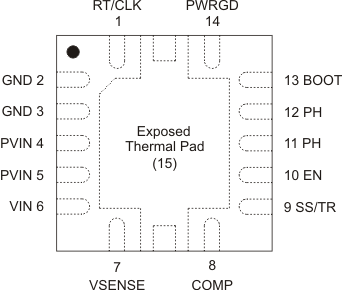SLVSB14B October 2011 – February 2016 TPS54821
PRODUCTION DATA.
- 1 Features
- 2 Applications
- 3 Description
- 4 Revision History
- 5 Pin Configuration and Functions
- 6 Specifications
-
7 Detailed Description
- 7.1 Overview
- 7.2 Functional Block Diagram
- 7.3 Feature Description
- 7.4
Device Functional Modes
- 7.4.1 Enable and Adjusting Undervoltage Lockout
- 7.4.2 Adjustable Switching Frequency and Synchronization (RT/CLK)
- 7.4.3 Adjustable Switching Frequency (RT Mode)
- 7.4.4 Synchronization (CLK mode)
- 7.4.5 Slow Start (SS/TR)
- 7.4.6 Power Good (PWRGD)
- 7.4.7 Bootstrap Voltage (BOOT) and Low Dropout Operation
- 7.4.8 Sequencing (SS/TR)
- 7.4.9 Output Overvoltage Protection (OVP)
- 7.4.10 Overcurrent Protection
- 7.4.11 Thermal Shutdown
- 7.4.12 Small Signal Model for Loop Response
- 7.4.13 Simple Small Signal Model for Peak Current Mode Control
- 7.4.14 Small Signal Model for Frequency Compensation
-
8 Application and Implementation
- 8.1 Application Information
- 8.2
Typical Application
- 8.2.1 Design Parameters
- 8.2.2
Design Guide - Step-By-Step Design Procedure
- 8.2.2.1 Typical Application Schematic
- 8.2.2.2 Operating Frequency
- 8.2.2.3 Output Inductor Selection
- 8.2.2.4 Output Capacitor Selection
- 8.2.2.5 Input Capacitor Selection
- 8.2.2.6 Slow Start Capacitor Selection
- 8.2.2.7 Bootstrap Capacitor Selection
- 8.2.2.8 Under Voltage Lockout Set Point
- 8.2.2.9 Output Voltage Feedback Resistor Selection
- 8.2.2.10 Compensation Component Selection
- 8.2.2.11 Fast Transient Considerations
- 8.2.3 Application Curves
- 9 Power Supply Recommendations
- 10Layout
- 11Device and Documentation Support
- 12Mechanical, Packaging, and Orderable Information
Package Options
Mechanical Data (Package|Pins)
- RHL|14
Thermal pad, mechanical data (Package|Pins)
Orderable Information
5 Pin Configuration and Functions
RHL Package
14 Pins
(Top View)
